
How the technology works
Explore how mechanistic modeling works.
| Virus-like particles (VLP) |
|
| Monoclonal antibodies (mAbs) |
|
| Bispecific antibodies |
|
| Adeno-associated viruses (AAVs) |
|
| Vaccines |
|
| Other resources |
Hydrophobic interaction chromatography
Flow-through processes
Derivation of isotherm and resin parameters
Business impact
Other:
|